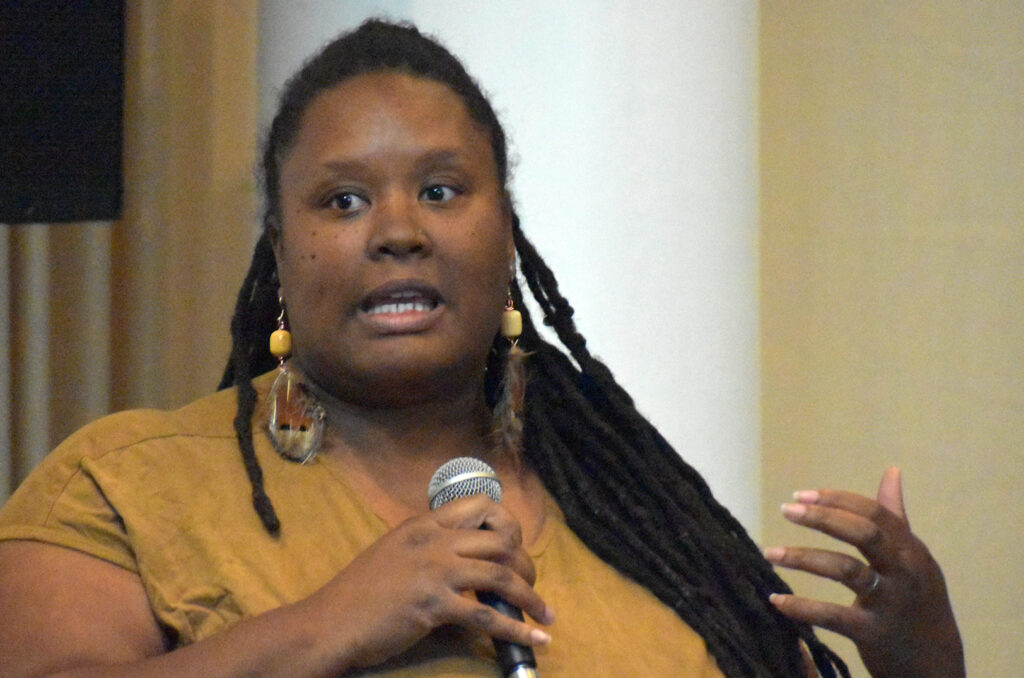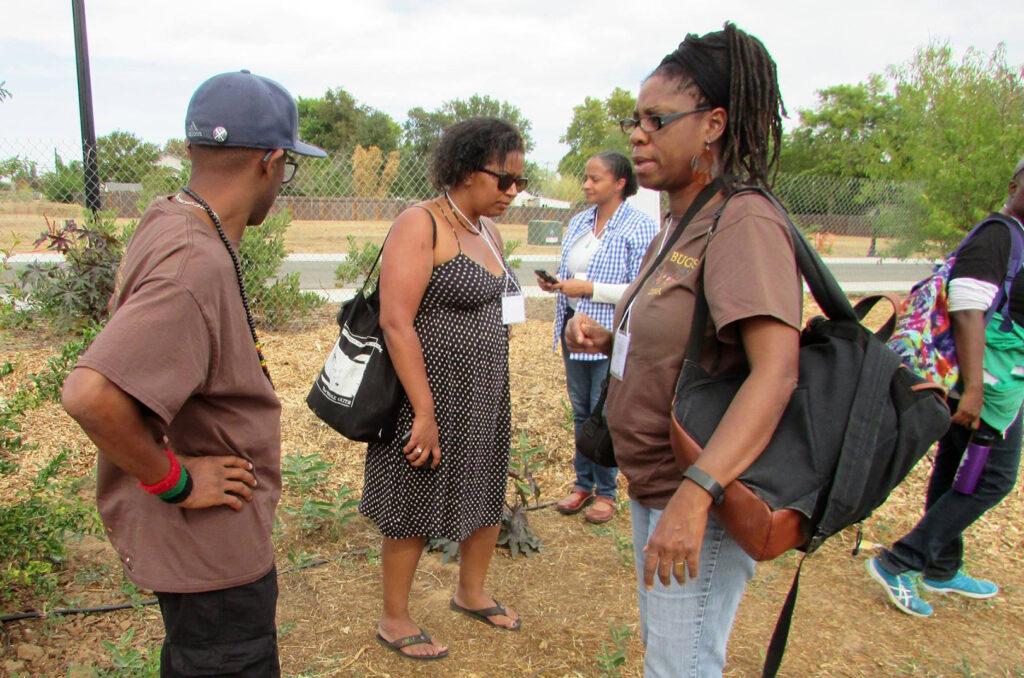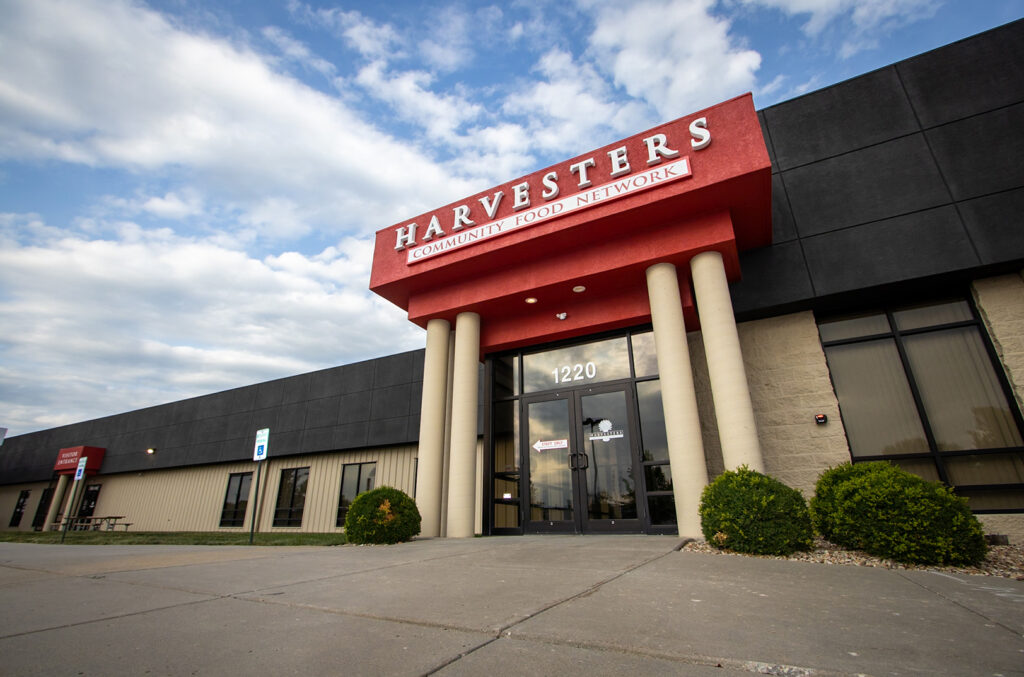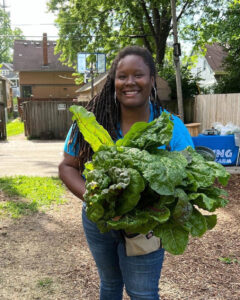when you want, where you want.
CJ Television
SNAP cuts are ‘worse than they look on paper’: Food access advocates warn shelves could go bare overnight
Chef Shanita McAfee-Bryant doesn’t mince words about perceptions of the hungry Kansas Citians she serves daily through her award-winning culinary social venture.
“These are the people who — if you listen to the rhetoric — are deemed ‘lazy,’” the founder of The Prospect KC’s NourishKC Community Kitchen told Startland News. “We know the narratives being painted about this community are just not true because we’re there with them every single day.”
For McAfee-Bryant, whose LaunchKC-backed culinary education initiative feeds hundreds, the stakes aren’t abstract. Rhetoric that paints individuals in need as the problem allows policy makers to easily target support efforts like the Supplemental Nutrition Assistance Program (SNAP) for cuts or outright elimination, she said.
And when SNAP benefits shrink, there’s a ripple effect straight from farmers losing support to nutrition education dollars drying up to reduced support for kitchens like hers — where Kansas Citians often maligned by critics of social safety nets rely on the day’s meal as their most substantial, and sometimes only, source of nourishment.
“It’s a plate of hope, it’s a plate of dignity. It’s all of those things,” McAfee-Bryant said.
Cuts and clawbacks from President Trump’s One Big Beautiful Bill Act — known by critics as the “Big Ugly Bill — threaten to take that plate away; not just from Kansas City’s most vulnerable residents, but from the ecosystem of growers, distributors, and nonprofits that keep food moving, she said.
And the tidal wave, McAfee-Bryant and other food access advocates warned, is only months away.
Impact on SNAP and related programs
Unprecedented cuts to SNAP funding as part of the budget bill — championed by Republicans as a sweeping rebuke of government waste and excess spending — are expected to have wide ranging impacts on programs from subsidies for growers and producers who supply food to participating retailers and dietary and wellness education programming. Among the fallout:
- Deep historic cuts to funding — The bill slashes upward of $300 billion in federal SNAP funding from through 2034, representing the largest cut in U.S. history, according to the Congressional Budget Office.
- Millions of families losing benefits — An estimated 22.3 million U.S. families could lose some or all SNAP benefits. Roughly 5 million of those families may see an average drop of $150/month.
- New work requirements and eligibility barriers — Adults aged 18-64 now must log 80 work hours per month to qualify (up from the previous threshold of 18-54), stripping exemptions from veterans, the homeless, foster youth, and more.
- States forced to pick up more of the tab — States with high error rates (above 6%) must now pay up to 15% of SNAP benefits, and administrative costs jump from 50% to 75% starting in FY 2027-28. Review the nation’s error rates here. Kansas, with an error rate of 9.98, is just below the national average of 10.93.
- Schools face deteriorating access to free and reduced-price meals — Various sources report that millions of children – as many as 18 million by some accounts – could lose access to the free meals they receive at school.
- Health consequences, including deaths — A memo from researchers at the Penn Leonard Davis Institute of Health Economics and NYU estimates 3.2 million people under 65 will lose SNAP eligibility, which could result in 93,000 premature deaths between now and 2039.
- Economic ripple effects — Combined SNAP and Medicaid cuts could wipe out 1.2 million jobs by 2029, shrink GDP by $154 billion, and reduce state/local tax revenues by roughly $12 billion – more harm than the federal budget savings.
For more information on how the current budget bill will impact Kansans, review this Center for American Progress fact sheet.

Alana Henry, executive director of the Ivanhoe Neighborhood Council, discusses the history of Black-led farming and efforts to limit it during a March town hall event curated by Black-owned Kansas City media outlets The KC Defender and The Kansas City Call at Independence Boulevard Christian Church; photo by Taylor Wilmore, Startland News
A triple threat to KC’s food system
Cuts to SNAP and related programs aren’t a single hit, said urban farming advocate Alana Henry; they’re a coordinated three-pronged blow to the entire local food ecosystem.
Ending farmer support programs
The first cut strikes at the roots: the loss of federal and USDA programs that helped local farmers grow and sell food.
Programs like the Local Food Purchasing Program once bridged the gap between urban farmers and large-scale distributors, providing critical financial incentives for farmers to sell to schools, food pantries, and local businesses, Henry said.
Now, many of those supports have been rescinded.
RELATED: Black farmers are losing ground in the fight to feed their communities, advocates say
“Farming is not lucrative. Urban farming has its unique challenges, and things like the local food purchasing program were great tools to bridge the gap between the urban farmer and larger food distributors,” explained Henry, who serves as the executive director of the Ivanhoe Neighborhood Council, as well as operations manager at Young Family Farm. “Now we don’t have that.”
ICYMI: USDA rakes back critical grant for farmers market
The downsizing of USDA’s local service centers compounds the damage, especially for urban and peri-urban farmers seeking FSA numbers, loans, or grants, she said.
Henry said funding is once again flowing primarily toward commodity crops and rural farming — products that don’t necessarily end up on local tables (and are now facing their own unique challenges related to Trump’s tariffs). Without such support, smaller farms risk losing their viability, and the momentum built during pandemic-era investments in local agriculture is fading fast.
Shrinking SNAP and EBT
The second cut undermines both sides of the market: consumers and the small farm businesses that serve them.
Reduced SNAP and EBT benefits mean fewer families can afford fresh produce — whether at the grocery store or a local farmers market — forcing more people into hard choices about how and when they feed their children, Henry said.
“In the community where I work, that’s a very real question,” she said. “How do I get my children fed? Or how do I get to where there are food resources so that they are fed?”
The loss of purchasing power ripples upstream to farmers markets and farm stands.
At Ivanhoe’s neighborhood market, many vendors rely on steady SNAP and EBT customers, especially in neighborhoods where the median household income is under $30,000 a year. Without those sales, some small farm businesses lose a critical revenue stream. Programs like Double Up Food Bucks, which doubled benefits for purchases from local farmers, are also at risk, further reducing incentives to buy fresh, local food.
Henry sees this as an economic development problem as much as a public health one:
“If you are only able to sell to folks who have the cash means or the credit card means, then you’re limited — especially if you’re in an area where the average income is already low,” she said.

Dina Newman, right, leads a Kansas City Black Urban Growers (KCBUGS) farm tour during an undated education event; courtesy photo
Education on the chopping block
The third cut attacks the long-term resilience of the community: education.
SNAP-Ed programs have been a cornerstone of teaching families how to grow food, prepare meals, and make nutritionally conscious choices. In Ivanhoe, that means hosting soil health workshops, garden stewardship classes, and youth gardening programs, often in partnership with extension campuses.
“Our aim is not just to get the food to the people — we do direct distribution — but also to empower and educate people on how to grow their own food and how to learn to cook food that is grown in a garden,” Henry said.
Losing education funding does more than reduce class offerings; Henry sees it as a deliberate narrowing of knowledge that could leave communities dependent on government and corporate supply chains. Without the skills to grow food or the infrastructure to support local producers, she warned, residents risk losing control over their own sustenance.
“If people don’t know how to grow their own food, and you cut the resources and supports for local growers, then you have a nation of people who are dependent entirely on the government or large corporations to make sure that you can eat,” she said. “Maybe that’s not alarmist — maybe that’s a forewarning.”

Harvesters food bank distribution center in Lawrence; photo by Haines Eason
Institutions can’t backfill what’s lost
Even the region’s largest food banks, like Harvesters — long considered a backstop — now warn they cannot possibly absorb the scale of loss and are bracing for failure.
Matt Hamer, who helps oversee operations at one of Kansas City’s primary food banks, said the scale of SNAP compared to charitable food programs is often misunderstood.
“For every one meal a food bank provides, SNAP provides nine,” Hamer said. “It’s definitely the most effective way there is in our country currently to help people. The charitable food sector doesn’t have the resources to be able to make up that difference, just speaking frankly.”
Harvesters is already being forced to “do more with less,” he said.
Federal programs that once supplied steady commodities to stock pantry shelves — including the Local Food Purchase Assistance program (LFPA) and a portion of The Emergency Food Assistance Program (TEFAP) — were recently cut or eliminated. That meant 41,000 cases of food ordered by the food bank never arrived, Hamer recalled, leaving warehouse shelves bare for the first time in his two-year tenure.
“It’s not our entire operation — about 15 percent of our food comes from the federal government — but that 15 percent is significant,” he said. “As food insecurity is the highest it’s been in a decade and increasing, we see more and more people reaching out to pantries for help while our resources are being cut at the same time.”
Strategic adjustments are underway, Hamer added. Harvesters’ local food bank is leaning harder on its data to identify the highest-need neighborhoods and direct resources there, rather than spreading thinly across overlapping pantries. While consolidation is a difficult word, the idea is simple: focus where the hunger is most acute.
“It’s something we’ve always looked at, but the SNAP cuts put it into sharper focus,” he said. “We want to make sure we’re getting the right amount of resources to the right areas where people are struggling the most.”
SNAP cuts threaten rural grocery stores
The concern isn’t only urban.
Hamer pointed to rural grocery stores that rely heavily on SNAP spending to stay afloat. With tight profit margins — often just 5 percent of sales tied directly to SNAP dollars — even a modest drop could tip stores into closure. That would leave many small-town residents without a local food source at all, further deepening regional food deserts.
“There are communities where they have one place to get food,” Hamer said. “If that store closes, people are driving 20, 30 miles or more. And a lot of people in rural areas are on SNAP. We are anticipating more stores closing and food deserts becoming even more stark.”
Still, he stressed Harvesters isn’t going anywhere. Advocacy efforts continue, both to educate the public on SNAP’s multiplier effect and to encourage new partnerships. Hamer said one in seven people in the food bank’s service area are already experiencing food insecurity — and likely more, given that official USDA numbers lag two years behind.
“Though things are bleak, people should understand the food bank’s not going anywhere. There are still resources out there, and SNAP is still a good program,” he said. “But it’s safe to assume the numbers are worse than they look on paper, and it’s going to hit people who are already barely making it.”
As food banks warn they can’t absorb the blow, Henry sees a chilling déjà vu: the same fragility exposed in 2020 when shelves went bare overnight.
From pandemic lessons to present risks
For Henry, the parallels to early pandemic disruptions are clear. When supermarket shelves went bare in 2020, it was local farmers who stepped in to fill the gap. She believes policymakers have forgotten that lesson.

Alana Henry, executive director of the Ivanhoe Neighborhood Council; courtesy photo
“It only takes a few weeks for our food system to collapse,” she said. “And when that happened, local growers were standing in that gap. How quickly we’ve forgotten.”
While Henry acknowledges the value of political advocacy, she cautioned against waiting for policy fixes. Instead, she urged individuals to either “learn how to do it yourself or support those who do,” whether by patronizing local farms, donating to community organizations, or promoting their work.
“We can’t expect the government to rescue us — the government is actually the entity creating all these problems,” she said. “The recipe is the community and the people around us working together in support of others.”
Henry’s message is blunt: Without intervention at the community level, Kansas City could see more residents facing hunger — not quietly, but in plain sight. And with the triple cut to farm support, consumer benefits, and food education, the infrastructure needed to reverse that trend is disappearing fast.
Shanita McAfee-Bryant echoed the same urgency:
“We’re going to save ourselves,” she said. “This isn’t going to be some big bailout. It’s going to be us, as humans, caring about our fellow humans and stepping up to the plate.”
Haines Eason is the owner of startup content marketing agency Freelance Kansas. Previously he worked as a managing editor for a corporate content marketing team and as a communications professional at KU. His work has appeared in publications like The Guardian, Eater and KANSAS! Magazine among others. Learn about him and Freelance Kansas on LinkedIn.
The post SNAP cuts are ‘worse than they look on paper’: Food access advocates warn shelves could go bare overnight appeared first on Startland News.
All Rights Reserved. Copyright , Central Coast Communications, Inc.